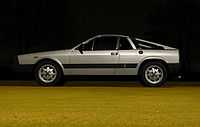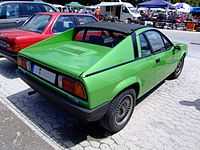Lancia Montecarlo
| Lancia Montecarlo | |
|---|---|
 | |
| Overview | |
| Manufacturer | Lancia |
| Also called |
Lancia Beta Montecarlo Lancia Scorpion |
| Production | 1975-1978 and 1980-1981 |
| Designer | Paolo Martin[1] at Pininfarina |
| Body and chassis | |
| Class | Sports car |
| Body style |
2-door Targa 2-door coupé |
| Layout | RMR layout |
| Related |
Lancia 037 Abarth SE 030 |
| Powertrain | |
| Engine |
1,995 cc straight-4 1,756 cc straight-4 (Scorpion) |
| Dimensions | |
| Wheelbase | 2,300 mm (91 in)[2] |
| Length | 3,810 mm (150 in)-3,965 mm (156.1 in) |
| Width | 1,690 mm (67 in)-1,696 mm (66.8 in) |
| Height | 1,190 mm (47 in) |
| Curb weight | 970 kg (2,140 lb)-1,075 kg (2,370 lb) |
The Lancia Montecarlo (Type 137) is a mid-engined sports car which was produced by Lancia in Italy from 1975 to 1981.
Cars from the first series, which were produced from 1975 to 1978, were known as Lancia Beta Montecarlos and those from the second series, produced from 1980 to 1981, simply as Lancia Montecarlos.[3] In both cases Montecarlo was spelled as one word, unlike Monte Carlo in the Principality of Monaco. Both series were offered in Coupé and Spider versions, the latter featuring a unique roll-back manually operated targa style convertible top. The Spider was sold in the United States as the Lancia Scorpion during 1976 and 1977.
Total production numbers come to 7,798 units,[4] with production spanning from 1974 until 1982 with an interruption in 1979. 3,558 first series and 817 second series targas were built; 2,080 first series and 1,123 second series coupés. There were also 220 competition models built (Lancia 037).
Design
This was a rear-wheel drive, mid-engined two-seater sports car that shared very few components with other Betas. The car was originally designed as Pininfarina's contender to replace Fiat's 124 Coupe, but lost out to Bertone's cheaper design, which became the Fiat X1/9.
At the early stages of development the Montecarlo was known as the Fiat X1/8 Project, commissioned by Fiat for Pininfarina to built a 3.0 litre V6 mid-engined sports car. X1/8 chassis was designed and developed for the first time in-house by Pininfarina and not based on any existing production car.[5] Due to Oil Crisis later the project was renamed X1/20 and updated to 2.0 litre. First car to be made out of X1/20 Project was Abarth SE 030 in 1974. The project was passed to Lancia, and was constructed by Pininfarina, the original design company, in Turin, Italy.[6] Lancia Beta Montecarlo was the first car to be made completely in-house by Pininfarina.[7]
Initial design drawing were done by 1969 and final design completed by 1971 by Paolo Martin at Pininfarina.
Lancia launched the Montecarlo as a premium alternative to the X1/9, with the 2 litre twin cam engine rather than the X1/9's single cam 1300. Both used a similar, based on the Fiat 128, MacPherson strut front suspension and disc brakes at both front and rear. Lancia Beta parts were limited to those from the existing Fiat/Lancia standard parts bin, the transverse mount version of the Fiat 124's twin cam engine and the five speed gearbox and transaxle.
Montecarlos were available as fixed head "Coupés" and also as "Spiders" with solid A and B pillars, but a large flat folding canvas roof between them. The very first examples had steel panels to the rear wings above the engine bay, but this limited vision made reversing difficult and it was replaced by glass panels. This gave a 'flying buttress' appearance to the rear, similar to the Maserati Merak.
First Series cars (1975–1978) were badged Lancia Beta Montecarlo. They were named "Montecarlo", written as one word, not Monte Carlo, one of Monaco's administrative areas. There was then a 2-year gap in production. The revised Second Series cars (1980–1981)[7] were simply badged as Lancia Montecarlo. In the United States of America the First Series cars were marketed as the Scorpion alongside the rest of the Beta range. Scorpion was used because General Motors had already used the name Monte Carlo for one of their cars. The Scorpion name was a reference to Abarth.
Racing
 Group 5 Lancia Beta Montecarlo Turbo competing in the 1980 World Championship for Makes. |
The Montecarlo was a successful turbocharged Group 5 racer and was used by Lancia to win the FIA's 1979 World Championship for Makes, 1980 World Championship for Makes and 1981 World Endurance Championship for Makes. Hans Heyer also won the Deutsche Rennsport Meisterschaft in 1980 at the wheel of a Montecarlo. Group 5 Lancia Montecarlo Turbo was finally available with 3 engine sizes: 440 hp 1,425.9 cc, 490 hp 1,429.4 cc and 490 hp 1,773.0 cc.[6]
Rallying
The Montecarlo was the basis for Lancia's successful Group B rally car the Lancia 037. The 037 retains the center section from the Montecarlo but little else. Its supercharged engine, while still mid-ship, is mounted longitudinally rather than transversely as it is in the Montecarlo.
Lancia Scorpion

The American market Lancia Scorpion was sold in 1976 and 1977, and was modified to meet American emissions, lighting and crash test requirements. The car is so called because the name Monte Carlo was already used in America by Chevrolet.
The Scorpion differed from the Montecarlo in a number of ways. It had a smaller twin-cam engine (1,756 cc) because the 1,995 cc unit in the Montecarlo did not pass U.S. emissions standards. Between the decrease in engine size and the addition of smog equipment, the Scorpion delivered just 81 hp (60 kW) vs. the 120 of the Montecarlo. The Scorpion had different bumpers to meet American crash tests and semi pop-up headlights with the 1976s having solid rear buttresses (Montecarlos had glass inserts except for very early models). All Scorpions featured the convertible top. Unlike the Montecarlo there was only one production run of Scorpions. A total of 1,801 were manufactured in 1976 and sold as model year 1976 and 1977 (1396 and 405 respectively).
Issues


The Montecarlo/Scorpion suffered from several issues. Between the taller springs used to meet the US height requirements, a lack of caster, and bump steer, handling of US market Scorpions did not meet the promises of the cars design.
The engine noise in the interior of the car was sometimes criticized; Road & Track listing noise as one of their biggest complaints about the car, with 'little joy listening to the wheeze of an emission equipment-stifled 4-banger',[8] and Motor calling the engine noise a 'raucous cacophony'.[9]
Harsh shifting is common and increases as the bushings wear (a common trait in mid-engined cars). The rear crossmember is a design flaw; the metal used was too thin and is susceptible to corrosion and eventual failure, although stronger replacement crossmembers are available from aftermarket companies.
The S1 Montecarlos and Scorpions suffered from overly boosted brakes, which caused the fronts to lock up easily in the wet. These were often criticised in reviews; for example Road & Track complained of 'severe front locking and 37% fade'[8] and Motor that they found 'it disconcertingly easy to lock up the front wheels when approaching corners'.[9]
As a result production was suspended in 1978 while the braking problems were resolved by some engineering changes including removing the brake servo. The S2 Montecarlo returned to the market in 1980 and introduced Marelli electronic ignition, which improved torque and the 0-60 speed (from 10 secs to 8.6).
Rust is an issue for the Montecarlo and Scorpion.[10] Unless kept in a dry environment active prevention is required to fend off rust. The firewall and wheel wells are common locations for rust. [citation needed] Rusted floor pans are a major cause of early Montecarlo/Scorpion demise.[citation needed]
In popular culture
- A Lancia Scorpion appeared in Disney's Herbie Goes to Monte Carlo (1977) as Herbie's girlfriend Giselle.
-

Lancia Montecarlo
-

US-market Lancia Scorpion
-
Lancia Montecarlo Badge
-

Lancia Montecarlo
-
1975 Lancia Montecarlo Spider with early solid buttresses
-

Group 5 Lancia Montecarlo Turbo
Notes and references
- ↑ "Paolo Martin Designer - Lancia Beta Montecarlo". martin.demaria.to.it. Retrieved 2012-11-10.
- ↑ "Lancia Montecarlo". carfolio.com. Retrieved 2007-11-21.
- ↑ Production Data Retrieved from lnx.betamontecarlo.it on 2 April 2009
- ↑ "Produzione Complessiva" [Cumulative Production] (PDF). pininfarina.it (in Italian). Archived from the original on 2011-06-05.
- ↑ "Fiat/Bertone X1/9, Lancia Montecarlo, Ferrari 308GT – Brio Trio – 174". classiccar.co.nz. Retrieved 2012-11-10.
- ↑ 6.0 6.1 "Lancia Montecarlo Development History". lanciamontecarlo.net. Retrieved 2012-11-09.
- ↑ 7.0 7.1 "Montecarlo Consortium - Our Cars". montecarlo.org.uk. Retrieved 2012-11-10.
- ↑ 8.0 8.1 Road & Track September 1976
- ↑ 9.0 9.1 Motor April 23, 1977
- ↑ BENJAMIN PRESTON, "Could Pretty Cars Be the Key to Attracting Younger Car Nuts?", The New York Times, June 4, 2013
External links
| « previous — Lancia Automobiles S.p.A., a subsidiary of the Fiat S.p.A. since 1969, car timeline, 1980s–present | |||||||||||||||||||||||||||||||||||||||||||
|---|---|---|---|---|---|---|---|---|---|---|---|---|---|---|---|---|---|---|---|---|---|---|---|---|---|---|---|---|---|---|---|---|---|---|---|---|---|---|---|---|---|---|---|
| Type | 1980s | 1990s | 2000s | 2010s | |||||||||||||||||||||||||||||||||||||||
| 0 | 1 | 2 | 3 | 4 | 5 | 6 | 7 | 8 | 9 | 0 | 1 | 2 | 3 | 4 | 5 | 6 | 7 | 8 | 9 | 0 | 1 | 2 | 3 | 4 | 5 | 6 | 7 | 8 | 9 | 0 | 1 | 2 | 3 | 4 | |||||||||
| Supermini | A112 | Y10 | Y | Ypsilon I | Ypsilon II | ||||||||||||||||||||||||||||||||||||||
| Small family car | Delta I | Delta II | Delta III | ||||||||||||||||||||||||||||||||||||||||
| Large family car | Beta | Prisma | Dedra | Lybra | Flavia II | ||||||||||||||||||||||||||||||||||||||
| Beta Trevi | |||||||||||||||||||||||||||||||||||||||||||
| Executive car | Gamma | Thema I | Kappa | Thesis | Thema II | ||||||||||||||||||||||||||||||||||||||
| Mini MPV | Musa | ||||||||||||||||||||||||||||||||||||||||||
| Large MPV | Zeta | Phedra | Voyager | ||||||||||||||||||||||||||||||||||||||||
| Racing car |
037 | Delta S4 | |||||||||||||||||||||||||||||||||||||||||
| Montecarlo Turbo | LC1 | LC2 | |||||||||||||||||||||||||||||||||||||||||
| |||||||||||||||||||||||||||||||||||||||||||||||||||||||||||||

